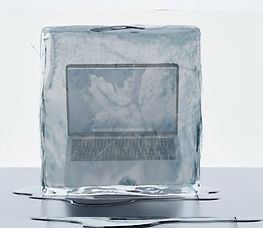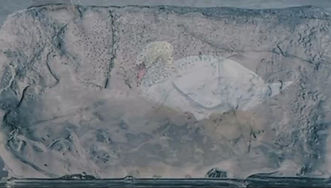Melting Time
A Slow Unveiling










“Melting Time” is a time-based, immersive installation centered on the idea that everything is in flux from the environment to human identity, from artistic expression to truth itself. In a space filled with paintings, digital works, and text-based media encased by ice, the exhibition transforms continuously as the ice melts and the works are revealed, altered, or even destroyed.
The space is filled with the sound of water droplets echoing through 10 speakers, creating a meditative, immersive environment. This melting process becomes both a visual and auditory experience
This exhibition is not static. Every visit is different, new pieces are introduced every day or two, ensuring that some works are freshly frozen, while others are partially revealed or almost fully visible. Transformation is the core experience: artworks don’t simply sit on walls; they evolve, dissolve, and re-contextualize as time and environment act upon them.
In the era of rapid technological change dominated by AI, automation, and hyper-connectivity “Melting Time” reflects on what it means to live in a time when nothing remains fixed. The exhibition is a mirror of our shifting reality: constantly rewriting itself, melting under the heat of progress, and unfolding in unpredictable ways.
Key Components or Elements
1. Melting Artworks (Physical & Digital)
-
Paintings in Ice: Traditional canvases encased in clear blocks of ice. As they melt, the paintings may become clearer, or degrade if exposed to dripping water. Each one has its own “melting story.”
-
Screens and Monitors: Embedded behind frosted Plexiglas or thin ice walls, looping video art or slow-moving AI-generated visuals that become visible as the ice recedes. Some screens glitch intentionally, mimicking digital decay and impermanence.
-
LED Text Banners: Display minimalist phrases or poetic fragments about identity, memory, and change scrolling continuously, sometimes partially obscured by condensation or dripping water.
-
Ephemeral Installations: Objects made of biodegradable or soluble materials that dissolve or deform as exposed to water over time.
2. Environmental & Spatial Design
-
Floor: The floor becomes part of the artwork wet, reflective, and marked by traces of past meltings. You can see puddles forming where pieces once stood. The space changes shape each day.
-
Soundscape: Ten dispersed speakers create an immersive, echoing environment of falling drops, low ambient tones, and glitch-like textures, evoking both the organic and the digital.
-
Cold, Dim Lighting: Subdued blue-white lighting reflects off icy surfaces. Small spotlights illuminate select works as they transform.
3. Live Evolution – Staggered Introduction of Pieces
-
New Works Every 2 Days (or when the time required) : Freshly frozen artworks are added continuously, ensuring that the room always contains different stages of transformation:
-
Newly installed and fully frozen works.
-
Mid-process works, where images and forms are beginning to emerge.
-
Nearly or fully revealed pieces, often altered or partially damaged by the process.
-
-
This staggered system creates a visual rhythm across the space, a timeline of decay and revelation, a literal and symbolic unfolding of change.
4. Interactive & Reflective Elements
-
Augmented Reflections: Mirrors or reflective puddles placed in the space show viewers not just themselves, but how they are part of the environment watching art change while they are also in motion.
-
Optional Mobile App / QR Integration: Visitors can scan QR codes near works to see images of the piece when it was first installed and compare its transformation.
Conceptual Background
A. Transformation as Reality
At its heart, this project is about the permanence of impermanence. Like the frozen artworks, our world is constantly shifting culturally, environmentally, and technologically. "States of Becoming" embraces the truth that nothing is static: not beauty, not truth, not the self. The exhibition doesn’t show you art as a fixed object, it makes you witness its mutation, just like the world around you.
B. The Age of Technological Flux
We are living through the Technological Revolution a period where AI, automation, and data are transforming the way we work, connect, and perceive reality. The frozen screens, glitching video loops, and LED text point to digital decay and obsolescence, questioning how long even “new” technology remains relevant. The melting of ice becomes a metaphor for the fragility of systems, both physical and virtual.
C. Climate & Collapse
The melting ice cannot be detached from its ecological implications. As glaciers disappear and sea levels rise, we are reminded that climate change is not abstract. In this space, it is personal and tactile the slow, irreversible loss of form and clarity.
D. Memory, Time, and Identity
Each piece exists in a temporal state part remembered, part forgotten, part unfinished. This reflects the way memory works in the human mind and the way identity reshapes over time especially in a digital era where personal narratives are constantly revised through online presence and algorithmic influence.
"Melting Time" is not just an exhibition it's a living, dissolving, self-renewing organism, where art undergoes the same shifts we do. It speaks to a world where the only constant is change, where the boundaries between physical and digital, natural and artificial, fixed and fluid are increasingly blurred.
By entering the space, the viewer doesn’t just witness transformation they become part of it. Time is visible. Loss is tangible. Discovery is slow and layered. As ice melts and art is revealed (or erased), we confront the transience of our surroundings and the fragility of what we once thought was permanent.
Ultimately, the exhibition asks: What do we cling to, and what are we ready to let melt away?




